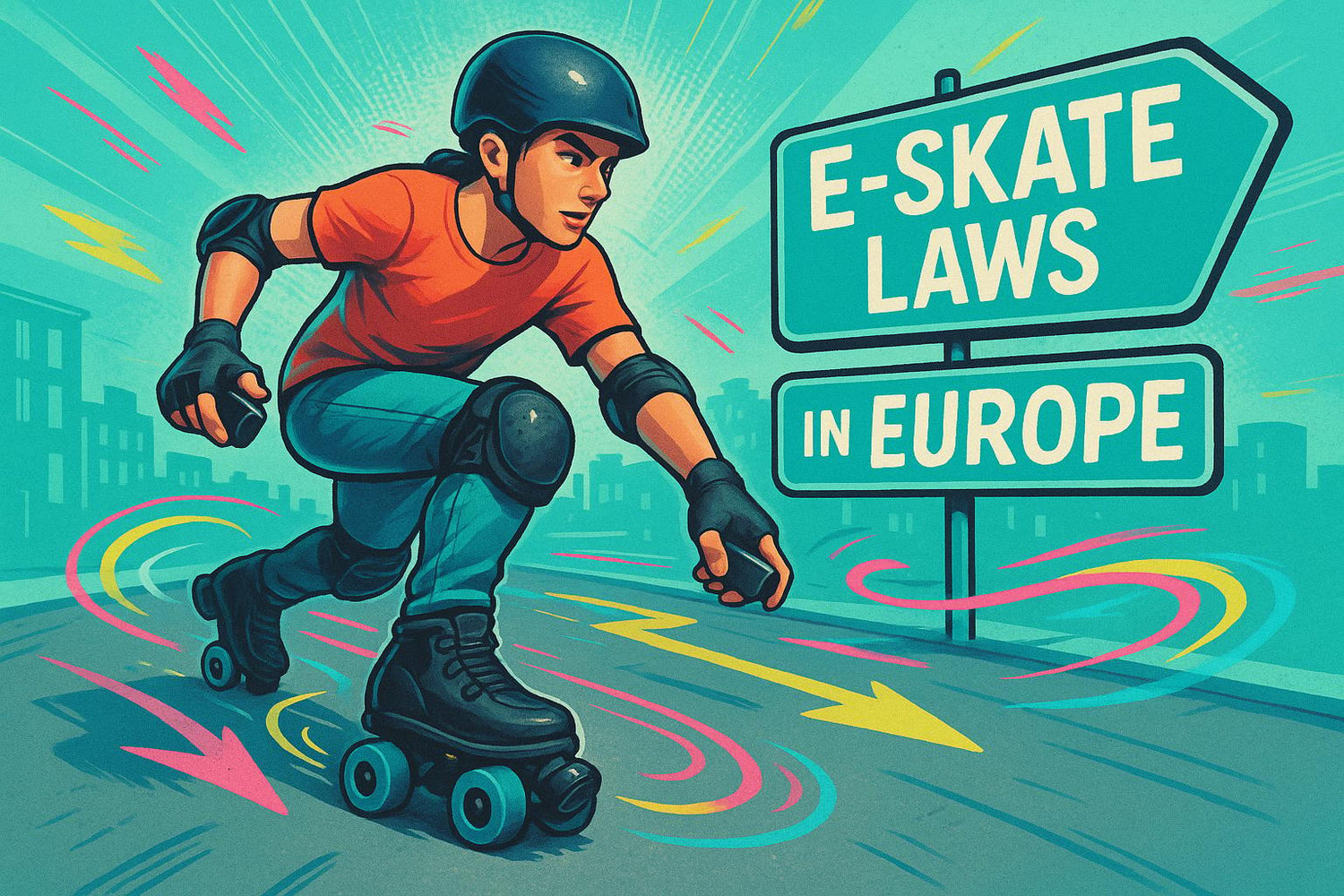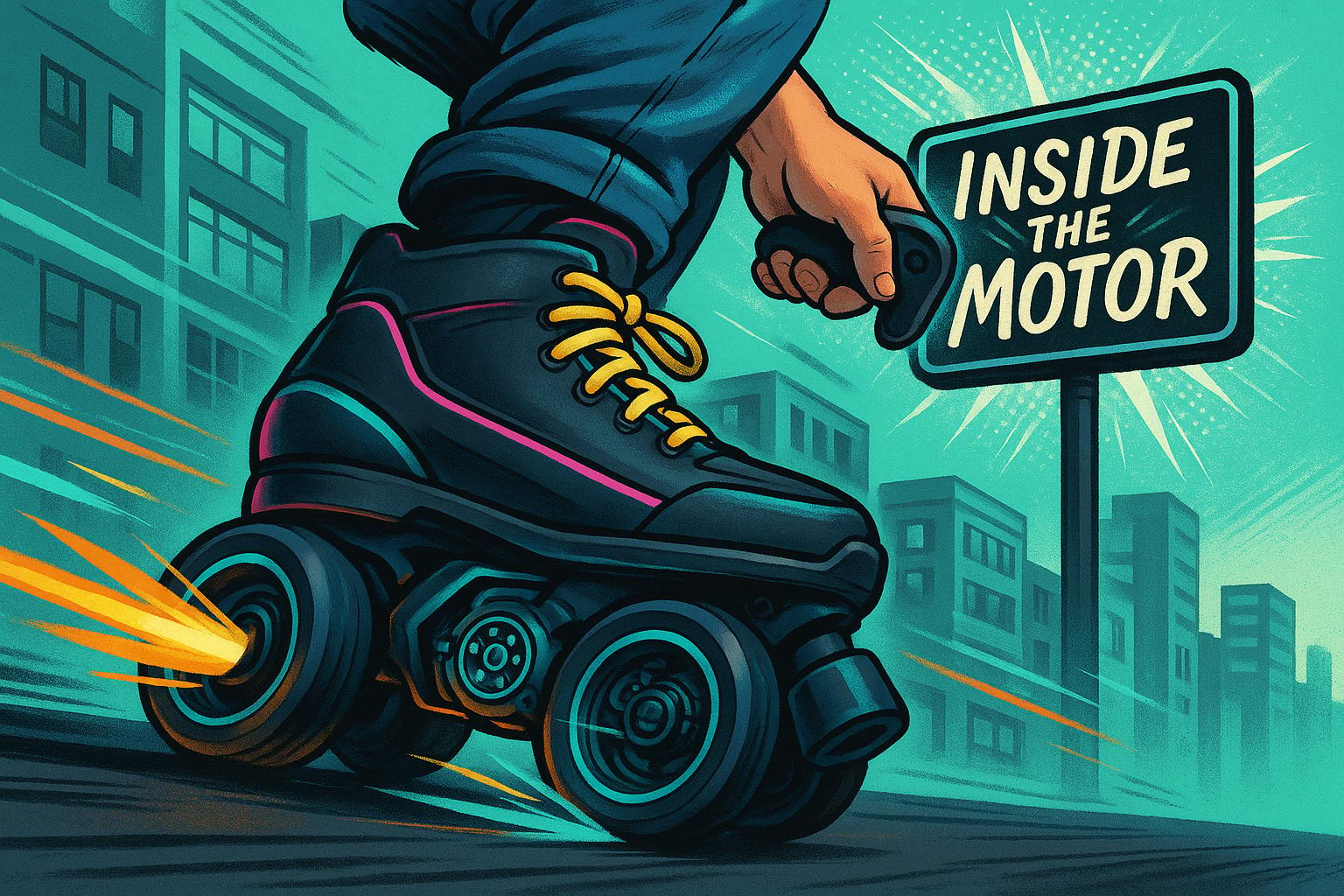Riding e-skates in Europe? Here's what you need to know:
- Laws vary by country: Each European country has its own rules for e-skates, from speed limits to where you can ride.
- Classifications matter: E-skates may be treated as bicycles, scooters, or even motor vehicles, affecting insurance, licenses, and registration.
- Safety gear is key: Many countries require helmets, reflective gear, and lights for visibility.
- Penalties exist: Breaking the rules can lead to fines, confiscation, or even riding bans.
- Stay updated: Regulations are constantly evolving, so check local laws before traveling.
Quick Tip: Always research the specific rules for your destination to avoid trouble and ride safely.
Electric Scooter Laws in Europe (Numerous Rules You Didn't Know)
How E-Skate Laws Work in Europe
Navigating e-skate laws in Europe can be tricky because regulations vary widely from one country to another. While the European Union (EU) has certain technical directives in place, there's no single legal definition for electric roller skates. Depending on the country, these devices might be classified as electric personal mobility devices or even motorized vehicles. This classification influences rules about where you can ride, speed limits, insurance requirements, and safety gear. Let’s break down how electric roller skates are defined and the role EU standards play in shaping these laws.
How Laws Define Electric Roller Skates
The way e-skates are classified legally often depends on factors like their power, maximum speed, and design. For instance, devices that exceed specific speed or power thresholds might face stricter rules, such as mandatory registration. Design elements can also play a role in distinguishing e-skates from other electric mobility devices. These definitions are critical, as they determine what regulations apply to e-skates in different countries.
Main EU Rules That Affect E-Skates
In addition to national laws, several EU directives set safety and technical standards for e-skates sold across Europe. For example, e-skates must meet minimum requirements for electrical construction, battery safety, and product quality, usually indicated by a CE marking. More advanced devices, like those with connectivity features, may also need to comply with GDPR regulations. However, individual countries still have significant control over specific rules, so riders must stay aware of both local laws and EU-wide standards that influence how e-skates are regulated throughout Europe.
E-Skate Laws by Country: Key Rules to Follow
Before hopping on your e-skateboard, it’s important to understand the laws in the area where you’ll be riding. While the European Union offers general guidelines, individual countries have their own specific regulations about where, when, and who can ride. Always double-check local laws, especially if you're traveling. Here’s a breakdown of key rules to keep in mind.
Speed Limits and Riding Zones
Speed limits and designated riding areas differ significantly across countries. Some enforce strict maximum speed limits and allow riding only in bike lanes or specific paths. Others have varying rules depending on whether you’re in urban or rural areas. To avoid fines or accidents, make sure you’re familiar with the local guidelines before setting out.
Age Restrictions and Insurance Requirements
Rules around rider age and insurance vary widely across Europe. Here are a few examples:
- Germany: Riders must be at least 14 years old. Liability insurance is mandatory, and you’ll need to display an insurance sticker on your e-skateboard. Additionally, an Allgemeine Betriebserlaubnis (ABE) is required to ride legally in traffic.
- France: The minimum age is 12, but kids between 8 and 12 can ride under adult supervision. While liability insurance isn’t required, it’s strongly recommended for added protection.
- The Netherlands: Riders must be at least 16 years old and hold a moped license for approved models. Third-party liability insurance is compulsory, and an insurance sticker must be displayed. Starting in July 2025, registration and license plates will also be required.
Safety Gear Essentials
Safety gear requirements aren’t uniform across Europe, but most countries stress the importance of protective equipment. Helmets are often recommended, and in some places, they’re mandatory. Items that enhance visibility, like reflective clothing or accessories, are also commonly required - especially for riding during early mornings or evenings. Always check the specific safety gear rules in your area to ensure compliance and stay safe on the road.
sbb-itb-bf837b9
Fines and Penalties for Breaking E-Skate Laws
Staying informed about the penalties tied to e-skate laws is essential for riding safely and within the law across Europe. Breaking these laws can lead to fines, confiscation of your e-skate, riding bans, and other legal consequences. This highlights the importance of knowing and following local regulations.
For example, failing to meet legal requirements - like having the right insurance or proper registration - can result in fines. In some cases, law enforcement might confiscate your e-skate. Getting it back often depends on fulfilling specific legal obligations.
Repeated or serious violations, such as reckless riding or causing accidents, can lead to riding bans. In extreme situations, authorities may impose long-term or even permanent restrictions on using personal mobility devices. Additionally, these violations could increase your insurance premiums or lead to mandatory safety training.
How Enforcement Differs in Cities vs. Rural Areas
Where you ride plays a big role in how the laws are enforced. In cities, with their heavy traffic and larger populations, enforcement tends to be stricter. Urban riders are more likely to face checks for insurance, registration, and safety equipment.
In rural areas, enforcement is usually less frequent and often happens after an incident or complaint. However, the penalties in these areas can still be severe, as local authorities aim to prioritize community safety.
Tourist hotspots, especially during peak seasons, may also see heightened enforcement as authorities work to manage the influx of visitors.
How to Ride E-Skates Legally in Europe
Navigating the legal landscape for electric roller skates in Europe can be tricky, but following a few key steps will help you stay compliant. Start by researching local rules and ensure your equipment meets the necessary legal standards.
Research Laws Before Riding in New Countries
Electric roller skate regulations can differ drastically between European countries, so it's essential to do your homework before riding in a new location. What's allowed in one country might be completely restricted in another.
To get the most accurate and up-to-date information, check official government websites. For instance, in March 2024, eSkate Hub provided direct links to legal resources for several European nations, including Austria, Czechia (Road Traffic Act), France, Greece, Lithuania, Poland, and Sweden. These links lead to the actual legal documents, ensuring you get precise details rather than outdated interpretations.
Classification is another critical factor. Some countries, like Finland, categorize electric roller skates based on their power and speed. Each classification comes with its own set of rules for things like lights, reflectors, and warning devices.
City-specific regulations can add another layer of complexity. In Spain, for example, rules can vary significantly from one city to another, so even after understanding national laws, it’s important to research local ordinances.
"Electric skateboarding laws vary significantly from country to country, and even within regions of the same country. As riders, it's crucial to stay informed about local regulations to ensure safe and responsible riding." – Bioboards Eskate
Keep Your Equipment Safe and Legal
To avoid fines or penalties, make sure your electric roller skates meet the technical requirements of the area you're riding in. Denmark’s 2018 law is a good example: skates must weigh no more than 22 pounds (10 kg), have a top speed of 12.4 mph (20 km/h), and offer a range of no more than 18.6 miles (30 km). Exceeding these limits could make your skates illegal.
Regular maintenance is not just a good habit - it’s often a legal necessity. Always check your speed settings to ensure they comply with local limits before heading out. Some countries cap power output at 1 kW, while speed limits can range from 9 mph to 15.5 mph (15–25 km/h). Make sure your skates can be adjusted to meet these requirements.
Safety equipment is another area where rules vary. In Finland, for example, skates classified as light electric vehicles must have front lights, reflectors, and an audible warning device. However, skates classified for pedestrian use do not require these features. Keeping a checklist for each country you visit can help ensure you’re always prepared.
Documentation is equally important. Some countries require registration, proof of insurance, or age verification. Keep both digital and physical copies of these documents handy to avoid issues during police checks.
How Wheelfeet Helps You Ride Legally

While riders are ultimately responsible for staying compliant, Wheelfeet makes it easier to meet legal standards. Their skates come with adjustable speed settings, allowing you to cap speeds at 9 mph, 12.4 mph, or 15.5 mph (15, 20, or 25 km/h), so you can align with local speed limits wherever you go.
The regenerative braking system ensures reliable stopping power, a crucial feature for safe use on public roads and bike lanes. With a top speed of 15 mph (25 km/h) and precise wireless remote control, Wheelfeet skates are designed to meet the requirements in most European countries.
Their lightweight build also complies with weight restrictions in regions like Denmark. Plus, the dual-mode functionality lets you switch to manual skating in areas where electric operation isn’t allowed. This flexibility ensures you can continue your journey safely, even in zones with stricter rules.
Conclusion: Follow the Rules and Stay Updated
Familiarizing yourself with local e-skate laws is crucial to riding both safely and legally. Regulations vary widely across Europe, with each country setting its own rules.
"There are no blanket rules for electric skateboard laws in Europe. Each country is individually regulating the use of eboards."
– eSkate Hub
This highlights the importance of staying informed, especially when traveling between countries.
Speed limits differ significantly across European nations, typically ranging from about 12.4 mph (20 km/h) to 15.5 mph (25 km/h) [5, 9, 11]. Given how quickly laws can change, it’s essential to check the latest regulations before hitting the streets.
Before crossing into a new country, take time to review its specific requirements. These may include rules about equipment like lights and reflectors, power output limits, age restrictions, or insurance policies. When unsure, reaching out to local authorities is the best way to ensure you’re riding within the law [5, 9, 11].
FAQs
How can I check the latest e-skate laws for a European country before traveling?
To keep up with the latest e-skate regulations in a specific European country, your best bet is to visit the official government transportation or legal websites for that nation. These sites usually have the most up-to-date and reliable information. For a broader perspective, you can also look into official EU mobility regulation pages.
For extra peace of mind, double-check trusted mobility or transportation websites just before your trip. This way, you can catch any last-minute updates, ensuring you're following local laws and riding responsibly.
What are the penalties for breaking e-skate laws in Europe?
Penalties for breaking e-skate rules in Europe differ by country, but they often include fines ranging from €135 to €960 (about $140 to $1,000). Beyond fines, authorities might take further steps like adding points to your driver’s license, seizing your e-skate, or even pursuing legal action.
The punishment typically matches the violation - whether it's speeding, riding in prohibited zones, or skipping mandatory safety gear. To steer clear of trouble, take the time to understand and follow the local regulations before hitting the road.
Do I need to register or get insurance for my e-skate when riding in Europe?
The rules for registering and insuring e-skates across Europe can differ significantly from one country to another. For instance, in Germany, riders are required to register their e-skates and carry liability insurance. In other countries, these requirements might only apply if the e-skate exceeds specific speed or weight thresholds. Some nations are still in the process of establishing their regulations and may not yet have clear guidelines in place.
To stay on the right side of the law, it's essential to familiarize yourself with the local regulations wherever you plan to ride. Depending on the country, you could need registration, insurance, or both, so double-checking the requirements beforehand is always a smart move.




Leave a comment
All comments are moderated before being published.
This site is protected by hCaptcha and the hCaptcha Privacy Policy and Terms of Service apply.